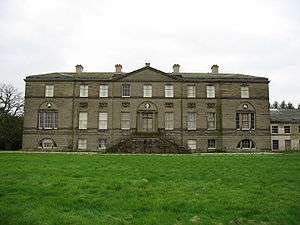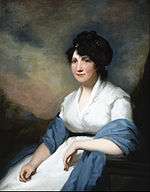Broughton baronets

The Broughton, later Broughton-Delves, later Broughton Baronetcy, of Broughton in the County of Stafford, is a title in the Baronetage of England. It was created on 10 March 1661 for Sir Brian Broughton, of Broughton Hall, near Eccleshall, Staffordshire, High Sheriff of Staffordshire from 1660 to 1661 and the member of an ancient Staffordshire family.
History[1]
The Broughtons are descended from the ancient Vernon family and in particular from Richard Vernon, fourth son of the 3rd medieval Baron Vernon of Shipbrook, Cheshire. Adam, his son, was of Napton, Warwickshire. Adams's grandson Roger acquired the estate at Broughton, Staffordshire, from which the surname derives, in the 13th century.
The first Baronet was the son of Thomas Broughton (died 1648) who was an ardent Royalist and supporter of Charles I and who was obliged to compound at a cost of £3200, for the return of his estates following sequestration by the Parliament at the conclusion of the Civil War. His son was honoured with the baronetcy at the Restoration of Charles II.
As of 13 June 2007 the presumed thirteenth and present Baronet, David Delves Broughton, has not proven his succession and is therefore not on the Official Roll of the Baronetage; the baronetcy has been dormant since 1993. For more information, follow this link. David Delves Broughton is the great-great-grandson of Reverend Sir Thomas Delves Broughton, second son of the eighth Baronet.[2]
The family seat is Doddington Hall, near Nantwich, Cheshire. It remains in the family of Sir Evelyn Delves Broughton, 12th Baronet.
Other members of the family
Several other members of the family have also gained distinction. William Robert Broughton (1762–1821), great-grandson of Charles Broughton, younger son of the first Baronet, was a Captain in the Royal Navy. Theodore Delves Broughton (1872–1944), grandson of Reverend Thomas Delves Broughton, eldest son of Thomas Delves Broughton, third son of the sixth Baronet, was a Colonel and temporary Brigadier in the Royal Engineers. William Edward Delves Broughton (1802–1880), second son of the aforementioned Thomas Delves Broughton, third son of the sixth Baronet, was a General in the Royal Engineers. His second son William Edward Delves Broughton (1837–1895) was a Major-General in the Bengal Army. Rhoda Broughton (1840–1920), daughter of the Rev Delves Broughton (1812–1863) and granddaughter of the 8th Baronet, the Rev Sir Henry Delves Broughton, was a noted author. Isabella Blow (née Delves Broughton) (1958–2007) was raised on the Doddington Park estate, a daughter of Sir Evelyn Delves Broughton, 12th Baronet. She was one of the most influential figures in fashion and art at the end of the 20th century.
Individual titleholders
- Sir Brian Broughton, 1st Baronet (1618–1708)[1]
- Sir Thomas Broughton, 2nd Baronet (died 1710)
- Sir Brian Broughton, 3rd Baronet (died 1724). Sir Brian Broughton's grandson, also named Brian, the third Baronet, was a Member of Parliament for Newcastle-under-Lyme. He married Elizabeth, daughter and sole heiress of Sir Thomas Delves, 4th Baronet, of Doddington (see Delves baronets).
- Sir Brian Broughton-Delves, 4th Baronet (1717–1744). The fourth Baronet, succeeded to the Doddington Park estate in Cheshire through his mother and assumed the additional surname of Delves according to the will of his maternal grandfather. He represented Wenlock in the House of Commons.
- Sir Brian Broughton-Delves, 5th Baronet (1740–1766). The fifth Baronet, died childless at an early age and was succeeded by his younger brother

- Sir Thomas Broughton, 6th Baronet (c. 1749 – 23 July 1813). Broughton was the second son of Sir Brian Broughton-Delves, 4th Baronet, and his wife Mary (née Forrester), and was educated at Magdalen College, Oxford. In 1766 he succeeded in the baronetcy on the death of his childless elder brother and the same year he reverted to the surname of Broughton only in lieu of Broughton-Delves.[3] Broughton was High Sheriff of Staffordshire in 1772 and Rector of Cheadle, Cheshire, between 1795 and 1807. He married firstly Mary, daughter of John Wicker, in 1766. They had several children, incl Maria who married Thomas Langford Brooke of Mere.[4] After her death in 1785 he married secondly Lady Anne, daughter of Other Lewis Windsor, 4th Earl of Plymouth, in 1787. There were no children from this marriage. After her death in 1793 he married thirdly Mary, daughter of Michael Keating and widow of Thomas Scott Jackson, in 1794. This marriage was also childless. Broughton died in July 1813, and was succeeded in the baronetcy by his eldest son from his first marriage, John. Lady Broughton died in November 1813.
- Sir John Delves Broughton, 7th Baronet (17 August 1769 – 9 August 1847). Sir John was the eldest son of Sir Thomas Broughton, 6th Baronet, by his first wife Mary (née Wicker). He served in the British Army and achieved the rank of General in 1830. He married Elizabeth, daughter of Philip Egerton, in 1792. They had no children. Broughton died in August 1847, aged 77, and was succeeded in the baronetcy by his younger brother, Henry. Lady Broughton died in January 1857.
- Sir Henry Delves Broughton, 8th Baronet (10 January 1777 – 3 November 1851). Sir Henry was a younger son of Sir Thomas Broughton, 6th Baronet, by his first wife Mary (née Wicker), and was educated at Rugby, Eton, Oriel College, Oxford, and Jesus College, Cambridge. From 1807 to 1829 he was Rector of Cheadle, Staffordshire. In 1847, at the age of 70, he succeeded his elder brother in the baronetcy. Sir Henry married Mary, daughter of John Pigott, in 1807. They had nine sons and nine daughters. He died in November 1851, aged 74, and was succeeded in the baronetcy by his eldest son, Henry. Lady Delves Broughton died in December 1863.
- Sir Henry Delves Broughton, 9th Baronet (1808–1899). High Sheriff of Staffordshire in 1859.
- Sir Delves Louis Broughton, 10th Baronet (1857–1914)
- Sir Henry John Delves Broughton, 11th Baronet (1883–1942)
- Sir Evelyn Delves Broughton, 12th Baronet (2 October 1915 – 5 January 1993). Sir Evelyn was educated at Eton College and Trinity College, Cambridge. 2nd Lt, Irish Guards, Major RASC.[5] He inherited his baronetcy from his father, 'Jock' Delves Broughton, in 1942. In 1947, he married Hon Elizabeth Florence Marion Cholmondeley. In 1955, he married Helen Mary Shore, with whom he had four children, including Isabella Blow, to each of whom he left only £5,000 of his estate,[6] having already provided for them. In 1964 his only son, John, died aged two by drowning in an ornamental pool.[7] Following separation from his second wife in 1972, in 1974 he married his third wife, Rona Cramond (née Clifford Johns).[8] As he left no surviving son, his distant cousin David Delves Broughton was probably heir, but his claim to the title remains so far unproven.[2]
- David Delves Broughton, presumed 13th Baronet (born 1942)
The presumed heir presumptive is Geoffrey Delves Broughton (born 1962).
See also
Notes
- 1 2 The Baronetage of England, Containing a Genealogical and Historical Account of all Baronets now existing Vol II E Kimber and R Johnson (1771). Pedigree of Broughton. Google Books
- 1 2 No Sir! You are not a Baronet yet, William Cash, Sunday Telegraph, 6 July 2003
- ↑ Deed Poll Office: Private Act of Parliament 1766 (7 Geo. 3). c. 16
- ↑ Burke, J. (1836). A Genealogical and Heraldic History of the Commoners of Great Britain and Ireland Enjoying Territorial Possessions Or High Official Rank: But Uninvested with Heritable Honours. 3. Colburn. p. 626. Retrieved 13 April 2015.
- ↑ Who's Who 1988
- ↑ £3,962,702 net (Latest wills, The Times, 5 April 1997) but wrongly reported as £6m in Isabella Blow articles such as Blow by Blow, Tamsin Blanchard, The Observer, 23 Jun 2002, and her 2007 obituaries
- ↑ Heir To Baronetcy Found Drowned, The Times, 14 Sep, 1964
- ↑ Lundy, Darryl. "Major Sir Evelyn Delves Broughton, 12th Bt.". The Peerage. cites Mosley, Charles, ed. (2003). Burke's Peerage, Baronetage & Knightage (3 volumes). 1 (107th ed.). Wilmington, Delaware, U.S.A.: Burke's Peerage (Genealogical Books) Ltd,. p. 533.
References
- Kidd, Charles, Williamson, David (editors). Debrett's Peerage and Baronetage (1990 edition). New York: St Martin's Press, 1990,
- The Baronetage of England, Containing a Genealogical and Historical Account of all Baronets now existing Vol II Edward Kimber and Richard Johnson (1771). Pedigree of Broughton. Google Books
- Lundy, Darryl. "Major Sir Evelyn Delves Broughton, 12th Bt.". The Peerage.
- Mosley, Charles, ed. (2003). Burke's Peerage, Baronetage & Knightage (3 volumes). 1 (107th ed.). Wilmington, Delaware, U.S.A.: Burke's Peerage (Genealogical Books) Ltd,. p. 533.
- Leigh Rayment's list of baronets
- Records of an Old Cheshire Family